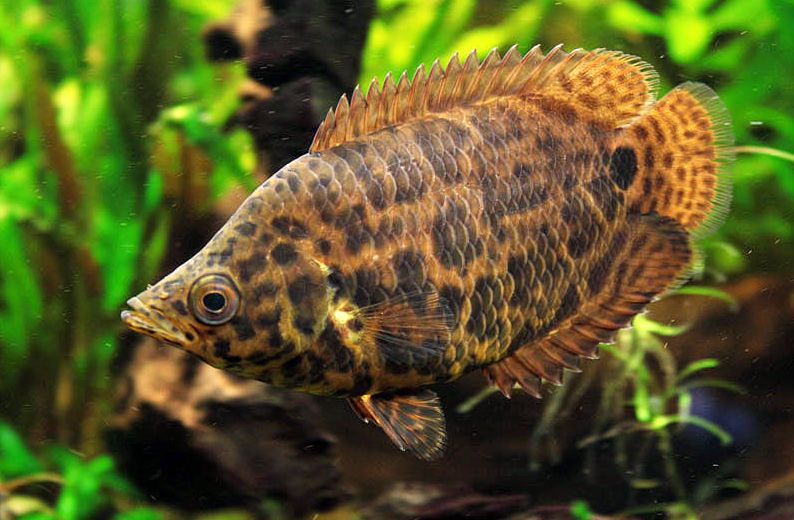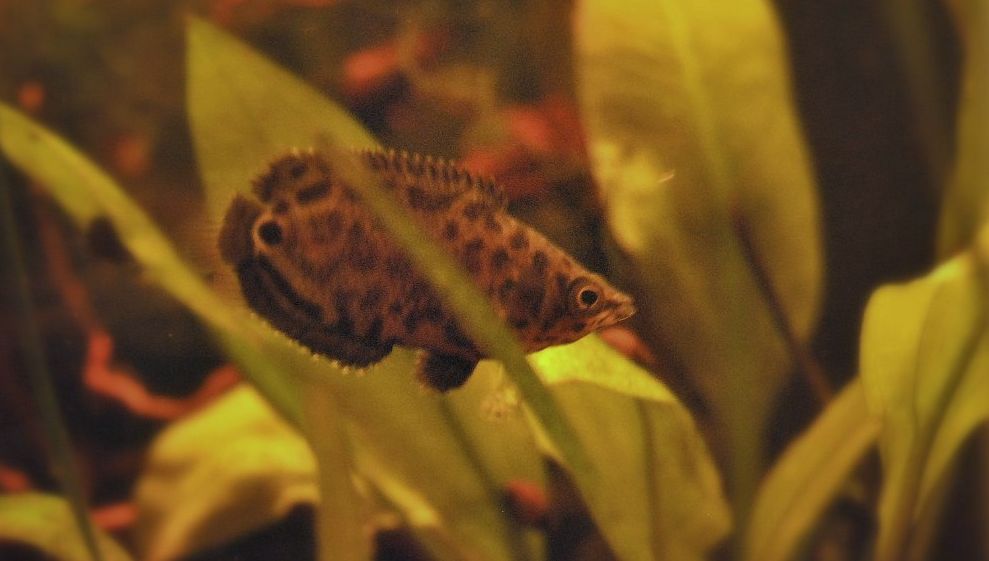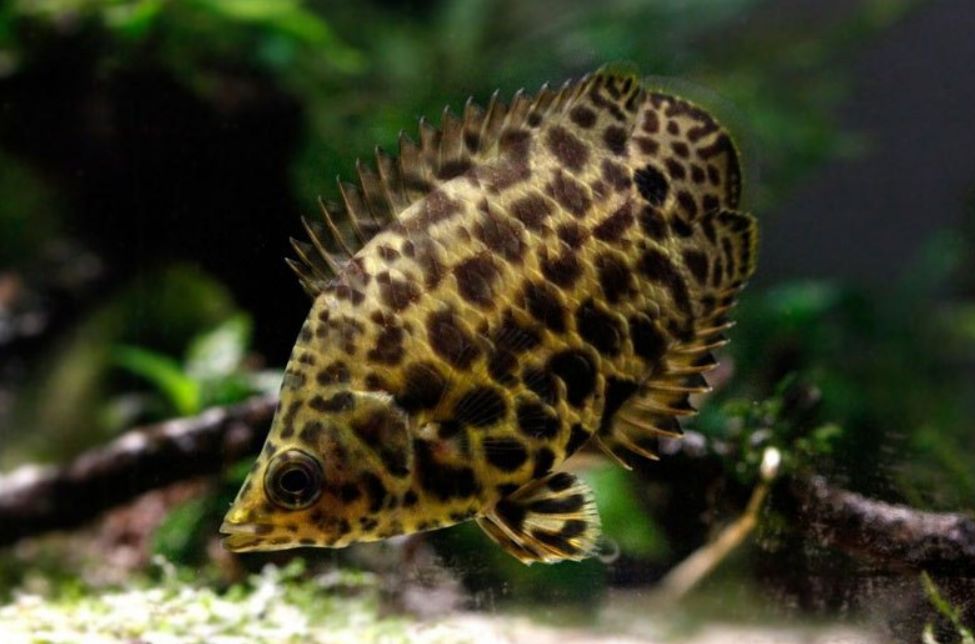The leopard bush fish or spotted ctenopoma (Ctenopoma acutirostre) is a fish kind from Anabantidae family. Is a predator by nature and any small tank dwellers which it can swallow can become its prey. For example, juveniles and small sized fishes, various amphibians, fish eggs, insects, shellfish, small sized crustaceans and other spineless species.

Contents
Habitat in the wild
The leopard ctenopoma, also known as Ctenopoma acutirostre, is a species of African freshwater fish belonging to the Anabantidae family. The Anabantidae family is commonly referred to as the “climbing gouramis” or “labyrinth fish” family.
These fish are native to various parts of Africa, particularly the central and western parts of the continent, including countries like Nigeria, Cameroon, and the Democratic Republic of the Congo.
The leopard gourami origins from Africa. It inhabits in Congo river basin within the territory of modern Republic of the Congo and Democratic Republic of the Congo. The fish can be encountered in different biotopes varying from rivers to lentic habitats. They can be found in freshwater habitats such as slow-moving rivers, streams, ponds, swamps, and marshes with dense vegetation.
These fish are well adapted to living in environments with plenty of hiding spots and cover, as they are known to be shy and reclusive in the wild. They often seek refuge among submerged aquatic plants, fallen branches, and other debris. The leopard bush fish is most active during the night time and at day it usually hides among the thick underwater vegetation.
In their natural habitat, they are opportunistic predators, feeding on small invertebrates, insects, and crustaceans. If the fish gets exited with the hunting process, it can even start to chase its prey, but more often it attacks from the hide by masking successfully among aquatic vegetation and waiting till its prey comes closer.
Description
Size
Adult species can full grown up to 20 cm (8 in) long. However, in a tank species very seldom exceed the length of 15 cm (6 in). Remember that the size of the aquarium and the overall environment play a significant role in the well-being and development of the fish.
Lifespan
On average, in captivity, Leopard Bush Fish can live anywhere from 5 to 8 years or possibly even longer with proper care. Providing them with a suitable environment, a balanced diet, and regular water maintenance can contribute to their overall health and longevity.
Keep in mind that individual fish may have different lifespans, and some may live shorter or longer than the average range. As with any pet, giving them the best possible care and attention will enhance their chances of living a healthy and fulfilling life.
Body and color
The body is tall and a bit flattened from sides; its mouth is elongated and the eyes are large.
In some cases, the Leopard Bush Fish can change its body color slightly to match its environment or to communicate its mood. For example, they may darken their color when feeling threatened or stressed.
The fish has a patterned coloring – it has dark spots scattered over its yellowy-brown body and fins. Such a coloring is quite similar to leopard one and it completely hides the body outlines. There is a vertical bright colored stripe on the tail-stem. As the name suggests, this fish has a beautiful leopard-like spotted pattern on its body, which helps it camouflage among aquatic vegetation in its natural habitat. The spots can vary in color from dark brown to black, contrasting against a lighter background.
The leopard bush fish has a dark colored tail which makes it complicated to define the actual size of the fish. There is also a spot on the tailset which shape resembles an eye. Sometimes you may encounter the species with so dark coloring that makes their spots barely visible.
| Characteristic | Description |
|---|---|
| Scientific Name | Ctenopoma acutirostre |
| Common Name | Leopard Ctenopoma, Leopard Bush Fish, Spotted Climbing Perch, Spotted Ctenopoma, Spotted African Leaf Fish |
| Family | Anabantidae |
| Native Region | Central and Western Africa |
| Habitat | Slow-moving rivers, streams, ponds, swamps, marshes |
| Preferred Water pH | Slightly acidic to neutral (pH 6.0 to 7.0) |
| Preferred Water Temperature | 72°F to 82°F (22°C to 28°C) |
| Size | Up to about 4-6 inches (10-15 cm) in length |
| Lifespan | Around 5 to 8 years in captivity |
| Behavior | Shy and reclusive, seeks refuge in vegetation and cover |
| Diet | Carnivorous, feeds on small invertebrates and insects |
| Special Feature | Possesses a labyrinth organ to breathe atmospheric air |
| Aquarium Requirements | Plenty of hiding spots, access to the water surface for breathing, a well-maintained planted aquarium |

Difficulties in keeping
This is a rather enduring and undemanding fish kind. It is considered to be a real long-liver among its relatives. However, the leopard bush fish is rather timid, it prefers staying close to thick vegetation and snags. Hiding there the fish spends most of its time. It has a very calm and quiet temper. Mainly it tries to keep close to the bottom and it doesn’t swim higher than a middle water layer.
Other predator fish species can hardly find the leopard bush fish, since due to its specific coloring and body shape it easily disguises itself. The fish is especially active at night time. It loves chasing small sized tank dwellers.
Keeping in a tank
Tank size
For a single leopard bush fish, a minimum tank size of around 20 to 30 gallons would be suitable. To keep a couple we’d recommend you to get a thickly planted tank of at least of 50 gallons capacity. However, it’s essential to consider their territorial nature. If you intend to keep multiple leopard bush fish together, you’ll need a larger tank to accommodate their potential territorial behaviors and to provide enough space for each fish to establish their territories. It is desirable to decorate the tank with branchy snags, caves, stony hills, etc. and at the same time you should leave enough of free space for the fish to swim.
If you plan to keep a group of these fish, a tank size of at least 70 gallons or more would be ideal. Providing a larger tank with ample swimming space and multiple hiding spots will help reduce aggression and stress among the fish. Additionally, having live plants and decorations in the aquarium will create a more natural and stimulating environment for the fish. The plants will provide cover and hiding places, while driftwood and rocks can also be used to create caves and additional hiding spots.
The fish is a territory dependent one, that’s why it’s not a very good idea to introduce some new tank dwellers into the tank community that has already been formed. Since, in this case there will be lots of territorial conflicts in the tank. The best option for successful keeping of such a fish is a species tank with a large bottom area.
Water parameters
Optimal tank water parameters are the following:
- Temperature: Ideally, the water temperature should be kept between 72°F to 82°F (22°C to 28°C). Avoid drastic temperature fluctuations as they can stress the fish.
- pH Level: Leopard bush fFish prefer slightly acidic to neutral water conditions, with a pH range of around 6.0 to 7.0.
- Water Hardness: Aim for a moderate water hardness level, with a general range of 5 to 15 dGH (degrees of general hardness).
- Ammonia and Nitrite: Keep ammonia and nitrite levels at 0 ppm (parts per million). These substances are toxic to fish, and any presence of them in the water can be harmful.
- Nitrate: Nitrate levels should be kept low, ideally below 20 ppm. Regular water changes and proper filtration can help maintain low nitrate levels.
- Filtration: As always, it’s essential to maintain good water quality and provide appropriate filtration for the tank. Regular water changes and monitoring of water parameters are necessary to keep the Leopard Bush Fish healthy and thriving in their environment.
- Water Movement: Leopard Bush Fish come from slow-moving waters, so avoid strong water currents in the aquarium. Gentle water circulation is sufficient, as long as it doesn’t stress the fish.
Substrate
As for the bottom substrate, it should be neutral; its composition and nutritiousness depend on the requirements of the tank plants growing in this particular tank.
Lighting
The fish doesn’t require bright tank lighting, it prefers dim light and you can get such an effect by using fluctuant plants for natural light scattering (Amazon frogbit, Water Lettuce).
Diet
The Leopard Bush Fish (Ctenopoma acutirostre) is a carnivorous species with a diet that primarily consists of small invertebrates and insects. In their natural habitat, they are opportunistic predators, and their diet includes various types of aquatic and terrestrial prey.
In the wild, the leopard bush fish will feed on insects such as flies, mosquitoes, small crustaceans, and other aquatic invertebrates. They are known to be skilled hunters, using their excellent camouflage and patience to ambush their prey. Their elongated body shape and large mouth allow them to quickly snatch up their prey when it comes within striking distance.
Here are some suitable foods for leopard bush fish in captivity:
- Live or Frozen Foods: The best food is a live blood worm, tubifex and other live food of similar size. These foods closely mimic their natural prey and are highly nutritious. Frozen food will do as well in case of absence of live food. Optimal diet can consist of frozen shrimps, blood worm and even small live fishes, which the fish will eagerly chase.
- Pellets and Flakes: As for pellets, the fish eats it rather reluctantly. But you can train it to eat some specialized food, for example, high-quality commercial fish pellets and flakes designed for carnivorous fish can be included in their diet. Look for products that specifically mention compatibility with carnivorous species.
- Small Fish: Occasionally, they may accept small fish as part of their diet. However, it’s essential to ensure that the fish are appropriate in size and do not pose a choking hazard or carry any diseases.
- Insect-Based Foods: Some specialty fish foods contain a blend of insect meal and other nutritious ingredients. These can also be offered to provide dietary variety.
- Plant food: There is no need in feeding it with plant food.
Tank mates
There are almost no issues with the bush fish compatibility in a tank. The tank mates can be fishes of the similar size which require the same tank conditions These can be angelfish (or another cichlids) that are quite common dwellers in amateur tanks, swordtails and other fishes which size is large enough, so they won’t be swallowed by a ctenopoma.
Small sized species representatives (neon tetra fishes, guppy, etc.) can be treated by the fish as a potential prey. Since the fish has only one restriction: its prey should fit its mouth, which is rather large.
However, you shouldn’t keep a fish together with cichlid species which are too aggressive, since they’ll definitely attack this calm and a bit timid fish.
The fish demonstrates rather tolerant behavior towards other species (like bichir or african cichlids) of similar size and it can become rather timid, since other active tank mates may scare it. Therefore, to make sure that the fish won’t get stressed it is a must to have shelters in the tank. Flower pots, halves of coconut shells, thickly growing tank plants may be used as ones.
Intraspecific interactions between the fish species are based on dominance of alpha male on a specific territory and therefore in small tanks territorial fights are quite possible. You can avoid the issue, if the fish species grow up together and form their hierarchy as they grow.

Gender differences: male vs female
Determining the sex of Ctenopoma acutirostre can be a bit challenging, especially when they are young or not in breeding condition. However, there are some general differences that can help distinguish males from females as they mature:
- Size: In most cases, male tend to be slightly larger than females. As they reach maturity, the size difference may become more apparent, with males having a more elongated and robust body.
- Dorsal Fin: The dorsal fin of male is usually more elongated and pointed compared to that of females. In some cases, the male’s dorsal fin may also have more intense or prominent coloration.
- Anal Fin: Similar to the dorsal fin, the anal fin of male may also be more elongated and pointed compared to females.
- Coloration: While both male and female have the characteristic leopard-like spotted pattern, some male individuals may exhibit more intense and vibrant colors, especially during the breeding season. Females, on the other hand, might have slightly duller colors.
- Behavior: During the breeding season, males may exhibit more territorial and aggressive behavior, especially towards other males. They might also display courtship behaviors, such as chasing females and building nests.
- Breeding Tube: In mature males, a breeding tube, a tubular structure located behind the anal fin, may become visible during the breeding season. This is absent in females.
Breeding
You can rather seldom encounter successful cases of the breeding in an amateur tank. The leopard bush fish is quite sensitive when choosing a mate and chances to form at least just one couple get higher if you get a group of several species of the same age.
A couple of breeders can be formed in a group of young species, since they form couples themselves as they grow.
There is an assumption that the spawning coincides with some specific season of the year. And during this season they regularly spawn and they stop during the inter-season.
As the mating season comes the fish performs some specific mating display, during which the fish extracts hundreds of eggs which float on the water surface and they are to survive on their own after this.
The fish has no developed parental instincts and it doesn’t demonstrate any care towards its future offspring.
Moreover, the adult species may even eat their own eggs, that’s why to preserve them you should carefully remove the eggs and put them into another tank with the same water parameters.
Since the eggs are lighter than water, they float on the water surface. Unlike other climbing perches, the fish doesn’t show any concern about their offspring and that’s why after spawning is over, you can remove the fish parents from the tank right away.
The egg stage lasts about 48 hours. Despite the fact that the eggs are rather large sized, the larvae that hatches from them are rather small with a large yolk sac. In two days the yolk sac is completely reabsorbed and the larvae turn into the juveniles and significantly gain in size. Then they start to swim in the tank looking for food.
In two days the yolk sac is completely reabsorbed and the larvae turn into the juveniles and significantly gain in size. Then they start to swim in the tank looking for food.
You can use brine shrimp nauplii as a starting feed for the juveniles. In spite of the high fertility (it lays about several thousands of eggs), in a tank conditions survival rate of the juveniles is extremely low.